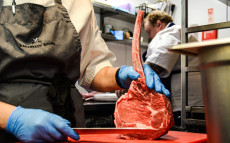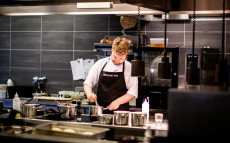- pathfindersAI
- Job Profile
Bakers
Summary
Career Profile: Baker
What They Do
Bakers are culinary artisans who specialize in producing a variety of baked goods such as bread, pastries, cakes, and cookies. These professionals not only follow recipes but also often create their own, blending ingredients to achieve the desired texture, taste, and appearance. Bakers play a pivotal role in food service establishments, ranging from small, family-owned bakeries to large commercial ovens in supermarkets. Their work is an intricate combination of science and art, requiring precision and creativity.
Job Responsibilities
The responsibilities of a baker can vary depending on the work environment, but typically include measuring and combining ingredients to craft doughs and batters, operating and maintaining various baking equipment, and monitoring the baking process to ensure products meet quality and safety standards. Additionally, bakers may decorate finished products with icing, glazes, or other toppings, as well as manage inventory, order supplies, and oversee cleanliness and organization within the bakery. Customer service often forms a part of their duties, especially in retail settings, where bakers might engage directly with customers to take orders or provide recommendations.
Essential Skills
Being a successful baker requires a blend of technical skills and personal attributes. Key skills include a thorough understanding of baking techniques and the chemistry of ingredients, strong attention to detail, and the ability to follow stringent safety and sanitation guidelines. Dexterity and physical stamina are also important, as baking can involve repetitive tasks and long hours on one’s feet. Additionally, creativity is crucial for developing new recipes and decorating baked goods, while good time-management skills help ensure efficient operations. Effective communication and teamwork are essential, especially in larger kitchen environments where coordination with other staff members is required.
Educational Pathways
Aspiring bakers can pursue various educational pathways, from formal culinary arts programs to on-the-job training. Many state colleges offer certificates or associate degrees in Baking and Pastry Arts, which provide a comprehensive education in baking techniques, kitchen management, nutrition, and food safety. These programs typically combine classroom instruction with hands-on laboratory experiences. For those who prefer learning on the job, apprenticeships or entry-level positions in bakeries can offer practical training under the guidance of experienced bakers. Additionally, obtaining certification from a recognized culinary organization, such as the Retail Bakers of America, can enhance one's credentials and employment prospects.
Career Prospects
The career prospects for bakers are diverse and promising. According to the U.S. Bureau of Labor Statistics, employment of bakers is projected to grow, fueled by the increasing interest in artisanal breads, gourmet pastries, and health-conscious baked goods. Bakers can find opportunities in various settings, including stand-alone bakeries, grocery stores, hotels, and restaurants. With experience, bakers may advance to supervisory or management positions, open their own bakery, or specialize in areas such as cake decorating or pastry arts. Continuous professional development through workshops and courses can also qualify bakers for more specialized roles and potentially higher earnings.
Conclusion
In conclusion, the profession of baking offers a fulfilling career path characterized by a harmonious blend of creativity, technique, and dedication. Bakers play a vital role in the culinary world, bringing joy and sustenance to many through their craft. With a variety of educational pathways and promising career prospects, individuals passionate about baking can look forward to a dynamic and rewarding professional journey. Whether working in a cozy neighborhood bakery or a bustling commercial kitchen, bakers have the unique opportunity to leave an indelible mark on the culinary experiences of their communities.
Video
Compensation
| State | Median Salary | Median Hourly | Positions |
|---|---|---|---|
| MN | 37,530 | 18.04 | 2,930 |
| AL | 29,360 | 14.11 | 1,940 |
| AK | 30,410 | 14.62 | 630 |
| AZ | 35,860 | 17.24 | 4,300 |
| AR | 26,090 | 12.54 | 1,520 |
| CA | 37,700 | 18.13 | 22,490 |
| CO | 38,780 | 18.65 | 3,810 |
| CT | 37,180 | 17.88 | 2,170 |
| DE | 32,410 | 15.58 | 260 |
| DC | 36,960 | 17.77 | 490 |
| FL | 31,760 | 15.27 | 16,460 |
| GA | 31,200 | 15.00 | 6,880 |
| HI | 37,090 | 17.83 | 1,000 |
| ID | 31,920 | 15.35 | 1,330 |
| IL | 34,780 | 16.72 | 11,570 |
| IN | 35,730 | 17.18 | 3,970 |
| IA | 32,800 | 15.77 | 2,580 |
| KS | 30,800 | 14.81 | 1,300 |
| KY | 33,350 | 16.03 | 1,780 |
| LA | 29,220 | 14.05 | 1,740 |
| ME | 35,140 | 16.89 | 1,360 |
| MD | 37,020 | 17.80 | 2,140 |
| MA | 38,090 | 18.31 | 4,900 |
| MI | 32,680 | 15.71 | 7,470 |
| MS | 31,090 | 14.95 | 1,100 |
| MO | 31,030 | 14.92 | 4,070 |
| MT | 35,140 | 16.90 | 1,100 |
| NE | 30,390 | 14.61 | 1,690 |
| NV | 36,710 | 17.65 | 2,120 |
| NH | 35,720 | 17.17 | 610 |
| NJ | 36,130 | 17.37 | 8,550 |
| NM | 30,330 | 14.58 | 1,190 |
| NY | 37,120 | 17.84 | 14,510 |
| NC | 28,220 | 13.57 | 8,660 |
| ND | 35,770 | 17.20 | 790 |
| OH | 30,880 | 14.85 | 8,700 |
| OK | 29,190 | 14.03 | 2,030 |
| OR | 36,040 | 17.33 | 3,930 |
| PA | 33,350 | 16.03 | 9,590 |
| RI | 31,250 | 15.02 | 1,370 |
| SC | 32,800 | 15.77 | 3,210 |
| SD | 34,800 | 16.73 | 330 |
| TN | 31,200 | 15.00 | 4,140 |
| TX | 29,590 | 14.23 | 18,650 |
| UT | 31,130 | 14.97 | 3,570 |
| VT | 36,670 | 17.63 | 750 |
| VA | 32,730 | 15.74 | 4,830 |
| WA | 40,260 | 19.35 | 4,900 |
| WV | 32,240 | 15.50 | 790 |
| WI | 34,690 | 16.68 | 3,490 |
| WY | 27,840 | 13.38 | 510 |
Similar Occupations
In this area you will find other occupations that are close to the one you were viewing in tasks, knowledge and work environment. If the primary job profile you are viewing isn't quite to your liking, take a look around and see what else is available.
Basic and Premium Accounts have more alternative occupations available than the Free account.

Butchers and Meat Cutters - 51-3021.00
Butchers and Meat Cutters are professionals responsible for preparing meat for consumer use by slaughtering, deboning, trimming, and cutting into various types of cuts, ensuring optimal quality and portion control. They also handle the storage, packaging, and display of meat products, adhering to sanitary and safety standards.
-
$37,650/yr
Median Pay -
136,330
Number of Jobs

Chefs and Head Cooks - 35-1011.00
Chefs and Head Cooks oversee the preparation, seasoning, and cooking of food, ensuring that dishes meet high standards of quality and presentation. They manage kitchen staff, plan menus, and maintain inventory to ensure a smooth and efficient culinary operation.
-
$58,920/yr
Median Pay -
172,370
Number of Jobs